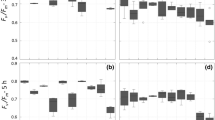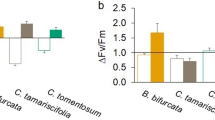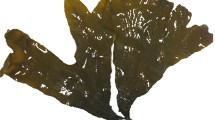Abstract
Non-motile organisms of intertidal shores such as seaweeds have to cope with a great variability of environmental factors. In this survey, we studied whether different morphotypes of the intertidal seaweed Fucus spiralis L. are also reflected in a characteristic performance. Desiccation and recovery of this Phaeophyceae were investigated in field experiments near Aljezur, Portugal. Fucus spiralis is exposed to serious desiccation during periods of falling tide, resulting in a tissue water loss of about 90%. Due to large semidiurnal tidal ranges in this area, two morphotypes can be distinguished: F. spiralis growing in the lower intertidal (LZ) is thicker and fleshier compared with plants in the upper intertidal (HZ), and this is reflected in a significant difference in fresh and dry mass. During sunny days and at low tide, effective quantum yields (ΦPSII) decreased significantly after 2 h desiccation. This continued until re-submersion. The photosynthetic performances of HZ and LZ plants also differed significantly after LZ plants were already submerged and photosynthetisizing, but the HZ specimens still exposed to air. Recovery experiments after desiccation treatments showed fast recovery within 6 min after re-submersion in both morphotypes. HZ specimens showed a slower recovery, which indicates a protection measure to the adverse conditions in the upper intertidal. In 24 h desiccation treatments, however, HZ specimens expressed a significantly higher maximum fluorescence yield Fv/Fm recovery. Simulated rainfalls during low tides caused photosynthetic activity to drop to 50% of initial Fv/Fm, independent of the length of the rain period. Treated plants also fully recovered after 6 min re-submersion in seawater. A comparison of single fronds and tufts clearly indicated advantages of the tuft growth strategy: tufts showed higher ΦPSII at prolonged emersion times. Our study indicated a clear relationship between size and drought resistance, which was primarily due to the smaller and hardy HZ plants that withstand longer desiccation times without damage.








Similar content being viewed by others
References
Bäck S, Collins JC, Russell G (1992) Comparative ecophysiology of Baltic and Atlantic Fucus vesiculosus. Mar Ecol Prog Ser 84:71–82
Beer S, Kautsky L (1992) The recovery of net photosynthesis during rehydration of three Fucus species from the Swedish west coast following exposure to air. Bot Mar 35:487–491
Beer S, Larsson C, Poryan O, Axelsson L (2000) Photosynthetic rates of Ulva (Chlorophyta) measured by pulse amplitude modulated (PAM) fluorometry. Eur J Phycol 35:69–74
Benet H, Bruss U, Duval JC (1994) Photosynthesis and photoinhibition in protoplasts of the marine brown alga Laminaria saccharina. J Exp Bot 45:211–220
Berard-Therryault L, Cardinal A (1973) Importance de certains facteurs ecologiques sur la resistance a la dessication des Fucacees (Phaeophyceae). Phycologia 12:41–52
Bergquist PL (1959) A statistical approach to the ecology of Hormosira banksii. Bot Mar 1:22–53
Bewley JD (1979) Physiological aspects of desiccation tolerance. Ann Rev Plant Pysiol 30:195–238
Biebl R (1970) Vergleichende Untersuchungen zur Temperaturresistenz von Meeresalgen entlang der pazifischen Küste Nordamerikas. Protoplasma 69:61–83
Björk M, Uku J, Weil A, Beer S (1999) Photosynthetic tolerances to desiccation of tropical intertidal seagrasses. Mar Ecol Prog Ser 191:121–126
Boaventura D, Ré P, Cancela da Fonseca L, Hawkins SJ (2002) Intertidal rocky shore communities of the continental Portuguese coast: analysis of distribution patterns. Mar Ecol 23:69–90
Brawley SH (1992) Fertilization in natural populations of the dioecious brown alga Fucus ceranoides L. and the importance of the polyspermy block. Mar Biol 113:145–157
Brown MT (1987) Effects of desiccation on photosynthesis of intertidal algae from a southern New Zealand shore. Bot Mar 30:121–127
Clogg CC, Petkova E, Haritou A (1995) Statistical methods for comparing regression coefficients between models. Am J Soc 100:1261–1293
Connell JH (1972) Community interactions on marine rocky intertidal shores. Annu Rev Ecol Syst 3:169–192
Coxson DS, Brown D, Kershaw KA (1983) The interaction between CO2 diffusion and the degree of thallus hydration in lichens: some further comments. New Phytol 93:247–260
Davis JS (1972) Survival records in the algae and the survival role of certain algal pigments, fat and mucilaginous substances. The Biologist 54:52–93
Davison IR, Pearson GA (1996) Stress tolerance in intertidal seaweeds. J Phycol 32:197–211
Demmig-Adams B (1990) Carotenoids and photoprotection in plants: a role for the xanthophyll zeaxanthin. Biochim Biophys Acta 1020:1–24
Demming B, Winter K, Krüger A, Czygan FC (1987) Photoinhibition and zeaxanthin formation in intact leaves. Plant Physiol 84:218–224
Dring MJ, Brown FA (1982) Photosynthesis of intertidal brown algae during and after periods of emersion: a renewed search for physiological causes of zonation. Mar Ecol Prog Ser 8:301–308
Dring MJ, Wagner A, Boeskov J, Lüning K (1996) Sensitivity of intertidal and sub tidal red algae to UVA and UVB radiation, as monitored by chlorophyll fluorescence measurements: influence of collection depth and season, and length of irradiation. Eur J Phycol 31:293–302
Erdmann N, Gademann M (2001) 11. Salt acclimation of algae and cyanobacteria: a comparison. In: Rai LC, Gaur JP (eds) Algal adaptation to environmental stresses. Springer, Berlin, pp 323–361
Field B, Behrenfeld J, Randerson T, Falkowski P (1998) Primary production of the biosphere: integrating terrestrial and oceanic components. Science 281:237–240
Fleming ED, Bebout BM, Castenholz RW (2007) Effects of salinity and light intensity on the resumption of photosynthesis in rehydrated cyanobacterial mats from Baja California Sur, Mexico. J Phycol 43:15–24
Geider RJ, Delucia EH, Falkowski PG (2001) Primary productivity of planet earth: biological determinants and physical constraints in terrestrial and aquatic habitats. Glob Change Biol 7:849–882
Genty B, Briantais JM, Baker NR (1989) The relationship between the quantum yield of photosynthetic electron transport and quenching of chlorophyll fluorescence. Biochim Biophys Acta 990:87–92
Gévaert F, Créach A, Davoult D, Migné A, Levavasseur G, Arzel P, Holl AC, Lemoine Y (2003) Laminaria saccharina photosynthesis measured in situ: photoinhibition and xanthophyll cycle during a tidal cycle. Mar Ecol Prog Ser 247:43–50
Gylle M, Isaksson D, Ekelund NGA (2009) Ecotype differentiation in qualitative content of water soluble organic compounds between marine and brackish Fucus vesiculosus L. (Phaeophyceae). Phycol Res 57:127–130
Hanelt D, Wiencke C, Karsten U, Nultsch W (1997) Photoinhibition and recovery after light stress in different developmental life-history stages of Laminaria saccharina (Phaeophyta). J Phycol 33:387–395
Hanelt D, Wienecke C, Bischof K (2007) Arctic alpine ecosystems and people in a changing environment. Part 3:251–277
Harker M, Berkaloff C, Lemoine Y, Britton G, Young AJ, Duval JC, Rmiki NE, Rousseau B (1999) Effects of high light and desiccation on the operation of the xanthophyll cycle in two marine brown algae. Eur J Phycol 34:35–42
Henley WJ, Levavasseur G, Franklin LA, Lindley ST, Ramus J, Osmond CB (1991) Diurnal responses of photosynthesis and fluorescence in Ulva rotundata acclimated to sun and shade in outdoor culture. Mar Ecol Prog Ser 75:19–37
Hunt LJH, Denny MW (2008) Desiccation protection and disruption: a trade-off for an intertidal marine alga. J Phycol 44:1164–1170
Huppertz K, Hanelt D, Nultsch W (1990) Photoinhibition of photosynthesis in the marine brown alga Fucus serratus as studied in field experiments. Mar Ecol Prog Ser 66:175–182
Kaltwasser J (1938) Assimilation und Atmung von Submersen als Ausdruck ihrer Entquellungsresistenz. Protoplasma 29:498–535
Karsten U, Mostaert AS, King RJ, Kamiya M, Hara Y (1996) Osmoprotectors in some species of Japanese mangrove. Phycol Res 44:109–112
Kirst GO (1989) Salinity tolerance of eukaryotic marine algae. Ann Rev Plant Physiol Plant Mol Biol 40:21–53
Krause GH, Weis E (1991) Chlorophyll fluorescence and photosynthesis: the basics. Ann Rev Plant Physiol Plant Mol Biol 42:313–349
Lamote M, Johnson LE, Lemoine Y (2007) Interspecific differences in the response of juvenile stages to physical stress: fluorometric responses of fucoid embryos to variation in meteorologiacal conditions. J Phycol 43:1164–1176
Lemonie Y, Harker M, Rminki NE, Rousseau B, Berkaloff C, Duval JC, Young A, Britton G (1995) Xanthophyll cycle operation and photoprotection in brown algae: effects of high light and desiccation. In: Mathis P (ed) Photosynthesis, from light to biosphere IV. Kluwer, Dordrecht, pp 119–122
Littler MM (1980) Morphological form photosynthetic performances of marine macroalgae: tests of a functional/form hypothesis. Bot Mar 22:161–165
Lobban CS, Harrison PJ (1994) Seaweed ecol and physiology, 1st edn. Cambridge University Press, Cambridge
Lüning K (1990) Seaweeds: their environment, biogeography, and ecophysiology. Wiley, New York, p 527
Madsen TV, Maberly SC (1990) A comparison of air and water as environments of photosynthesis by the intertidal alga Fucus spiralis (Phaeophyta). J Phycol 26:24–30
Magnusson G (1997) Diurnal measurements of Fv/Fm used to improve productivity estimates in macroalgae. Mar Biol 130:203–208
Maxwell K, Johnson GN (2000) Chlorophyll fluorescence—a practical guide. J Exp Bot 51:659–668
McCandless EL (1981) Polysaccharides of the seaweeds. In: Lobban CS, Wynne MJ (eds) The biology of seaweeds. Blackwell, Oxford, pp 559–588
Menge BA, Sutherland JP (1987) Community regulation: variation in disturbance, competition, and predation in relation to environmental stress and recruitment. Am Nat 130:730–757
Niemeck RA, Mathieson AC (1976) An ecological study of Fucus spiralis L. J Exp Mar Biol Ecol 24:33–48
Nybakken JW, Bertness MD (2005) Marine biology, an ecological approach, 6th edn. Pearson, Benjamin Cummings, San Francisco
Osmond CB (1994) What is photoinhibition? Some insights from comparisons of shade and sun plants. In: Baker NR, Bowyer JR (eds) Photoinhibition of photosynthesis, from the molecular mechanisms to the field. Bios Scientific, Oxford, pp 1–24
Ott J (1996) Meereskunde, 2nd edn. Ulmer, Stuttgart, p 424
Pearson GA, Brawley SH (1996) Reproductive ecology of Fucus distichus (Phaeophyceae): an intertidal alga with successful external fertilization. Mar Ecol Prog Ser 143:211–223
Pearson G, Kautsky L, Serrao E (2000) Recent evolution in Baltic Fucus vesiculosus: reduced tolerance to emersion stresses compared to intertidal (North Sea) populations. Mar Ecol Prog Ser 202:67–79
Rohacek K (2002) Chlorophyll fluorescence parameters: the definitions, photosynthetic meaning, and mutual relationships. Photosynthetica 40:13–29
Rugg DA, Norton DA (1987) Pelvetia canaliculata, a seaweed that shuns the sea. Plant life in aquatic and amphibious environments. Blackwell, Oxford, pp 347–358
Schonbeck MW, Norton TA (1979) An investigation of drought avoidance in intertidal fucoid algae. Bot Mar 22:133–144
Schonbeck MW, Norton TA (1980) Factors controlling the lower limits of fucoid algae on the shore. J Exp Mar Biol Ecol 43:131–150
Schreiber U, Bilger W (1987) Rapid assessment of stress effects on plant leaves by chlorophyll fluorescence measurements. In: Tenhunen JD, Catarino FM, Lange OL, Oechel WD (eds) Plant response to stress. Springer, Berlin, pp 27–53
Schreiber U, Bilger W (1993) Progress in chlorophyll fluorescence research: major developments during the past years in retrospect. Prog Bot 54:151–153
Schreiber U, Schliwa U, Bilger W (1986) Continuous recording of photochemical and non-photochemical chlorophyll fluorescence quenching with a new type of modulation fluorometer. Photosynth Res 10:51–62
Scott GW, Hull SL, Hornby SE, Hardy FG, Owens N (2001) Phenotypic variation in Fucus spiralis (Phaeophyceae): morphology, chemical phenotype and their relationship to the environment. Eur J Phycol 36:43–50
Serraõ EA, Pearson G, Kautsky L, Brawley SH (1996) Successful external fertilization in turbulent environments. Proc Natl Acad Sci USA 93:5286–5290
Stocker O, Holdheide W (1937) Die assimilation Helgoländer Gezeitenalgen während der Ebbzeit. Z Bot 32:1–59
Titus JE, Wagner DJ (1984) Carbon balance for two sphagnum mosses: water balance be solves a physiological paradox. Ecology 65:1765–1774
Via S, Gomulkiewicz R, De Jong G, Scheiner SM, Schlichting CD, Van Tienderen P (1995) Adaptive phenotypic plasticity: consensus and controversy. Trends Ecol Evol 10:212–217
Wetzel R, Likens G (1990) Limnological analyses, 2nd edn. Springer, Berlin
Young EB, Dring MJ, Savidge G, Birkett DA, Berges JA (2007) Seasonal variations in nitrate reductase activity and internal N pools in intertidal brown algae are correlated with ambient nitrate concentrations. Plant Cell Environ 30:764–774
Acknowledgments
Thanks to P. Lamprecht for accommodation in Portugal, C. Fesl for statistical hints, and the whole team from the Vienna Team Phycology for their support. Funding for the field study by the KWA University of Vienna is gratefully acknowledged.
Author information
Authors and Affiliations
Corresponding author
Additional information
Communicated by P. Kraufvelin.
Rights and permissions
About this article
Cite this article
Schagerl, M., Möstl, M. Drought stress, rain and recovery of the intertidal seaweed Fucus spiralis . Mar Biol 158, 2471–2479 (2011). https://doi.org/10.1007/s00227-011-1748-x
Received:
Accepted:
Published:
Issue Date:
DOI: https://doi.org/10.1007/s00227-011-1748-x




